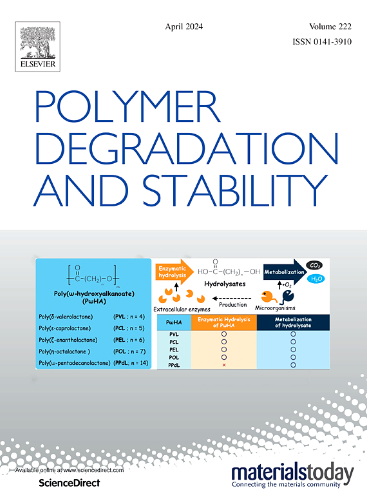Synergistic flame retardant coatings for carbon fibre-reinforced ε-caprolactam-based polyamide 6 composites: Fire performance and mechanical properties
IF 6.3
2区 化学
Q1 POLYMER SCIENCE
引用次数: 0
Abstract
The use of long fibre-reinforced thermoplastic composites is increasing, but a significant drawback is their flammability due to the organic matrix. This study explores the flame retardancy of carbon fibre-reinforced PA6 composites coated via in-mould coating. The matrix and coating were made by anionic ring-opening polymerisation of ε-caprolactam. The flame retardants used were magnesium oxide (MgO), red phosphorus (RP), hexaphenoxycyclotriphosphazene (HPCTP) and expandable graphite (EG). The flammability and fire performance were evaluated using pyrolysis-combustion flow calorimetry (PCFC), mass loss type cone calorimetry, and glow wire flammability index (GWFI) testing, while evolved gases were analysed using laser pyrolysis coupled with Fourier transform infrared spectrometry (LP-FTIR). Scanning electron microscopy (SEM) and energy dispersive X-ray spectroscopy (EDS) analysis of the solid residues post-combustion revealed the mechanisms responsible for flame retardancy. Flame retardant coatings reduced the peak heat release rate by up to 33 % and the total heat release by up to 40 % compared to the reference sample. The combination of flame retardants containing magnesium or phosphorus with expandable graphite resulted in a synergistic flame retardant effect due to the enrichment of the heteroatoms in the outer char layers, contributing to a more stable intumescent char and protective barrier layer. The LP-FTIR analysis indicated reduced emissions of toxic gases, particularly hydrogen cyanide (HCN) and carbon monoxide (CO), furthermore, it was found that flame retardants reduced the intensity of the peaks associated with C-H vibrations and P-related peaks appeared in the presence of HPCTP and RP. Overall, the combined flame retardant coatings improved the fire safety of carbon fibre-reinforced PA6 composites without compromising mechanical properties and mitigated the negative effect of carbon fibres on char formation.

碳纤维增强ε-己内酰胺基聚酰胺6复合材料的协同阻燃涂料:防火性能和力学性能
长纤维增强热塑性复合材料的使用越来越多,但一个显著的缺点是它们的可燃性,由于有机基质。采用模内涂层对碳纤维增强PA6复合材料进行了阻燃性研究。采用ε-己内酰胺阴离子开环聚合法制备基体和涂层。使用的阻燃剂有氧化镁(MgO)、红磷(RP)、六苯氧环三磷(HPCTP)和可膨胀石墨(EG)。采用热解燃烧流量热法(PCFC)、质量损失型锥量热法和灼热丝可燃性指数(GWFI)测试对其可燃性和防火性能进行了评估,同时采用激光热解结合傅里叶变换红外光谱法(LP-FTIR)对释放气体进行了分析。燃烧后固体残留物的扫描电镜(SEM)和能谱分析(EDS)揭示了其阻燃机理。与参考样品相比,阻燃涂层将峰值热释放率降低了33%,总热释放率降低了40%。含镁或磷的阻燃剂与可膨胀石墨的组合,由于在外焦层中杂原子的富集,产生了协同阻燃效果,有助于形成更稳定的膨胀焦和保护屏障层。LP-FTIR分析表明,阻燃剂减少了有毒气体的排放,特别是氰化氢(HCN)和一氧化碳(CO),此外,阻燃剂降低了与C-H振动相关的峰的强度,并且在HPCTP和RP存在时出现了与p相关的峰。总的来说,复合阻燃涂层在不影响机械性能的情况下提高了碳纤维增强PA6复合材料的防火安全性,并减轻了碳纤维对炭形成的负面影响。
本文章由计算机程序翻译,如有差异,请以英文原文为准。
求助全文
约1分钟内获得全文
求助全文
来源期刊

Polymer Degradation and Stability
化学-高分子科学
CiteScore
10.10
自引率
10.20%
发文量
325
审稿时长
23 days
期刊介绍:
Polymer Degradation and Stability deals with the degradation reactions and their control which are a major preoccupation of practitioners of the many and diverse aspects of modern polymer technology.
Deteriorative reactions occur during processing, when polymers are subjected to heat, oxygen and mechanical stress, and during the useful life of the materials when oxygen and sunlight are the most important degradative agencies. In more specialised applications, degradation may be induced by high energy radiation, ozone, atmospheric pollutants, mechanical stress, biological action, hydrolysis and many other influences. The mechanisms of these reactions and stabilisation processes must be understood if the technology and application of polymers are to continue to advance. The reporting of investigations of this kind is therefore a major function of this journal.
However there are also new developments in polymer technology in which degradation processes find positive applications. For example, photodegradable plastics are now available, the recycling of polymeric products will become increasingly important, degradation and combustion studies are involved in the definition of the fire hazards which are associated with polymeric materials and the microelectronics industry is vitally dependent upon polymer degradation in the manufacture of its circuitry. Polymer properties may also be improved by processes like curing and grafting, the chemistry of which can be closely related to that which causes physical deterioration in other circumstances.
 求助内容:
求助内容: 应助结果提醒方式:
应助结果提醒方式:


